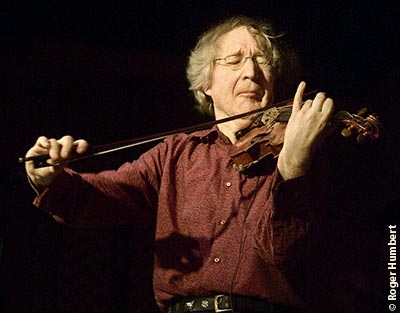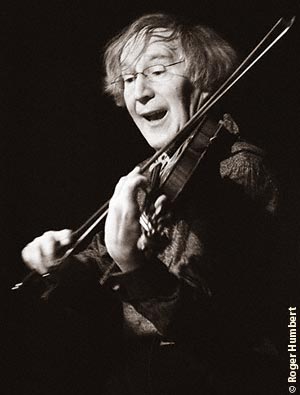
|
Helmut Lipsky with Berlin’s L’Art de Passage
presented by Gary Topp |
|
| February 25, 2007 • Lula Lounge • Toronto |
|
|
|
|
|
|
Au parfum du tango…
by Joyce Corbett with photos by Roger Humbert |
| Helmut Lipsky and Berlin’s L’Art de Passage took their places on stage against a backdrop of blue-red velvet. The warmth of the room, the strong, yet so far quiet presence of the performers, and the sumptuous curtain (left over from the venue’s previous incarnation as a cinema?), calmed the effect of the cold-blowing storm now unseen beyond the doors. Due to the inclemency, this would be one long set, instead of two, an uninterrupted, tango-infused journey. |
| We entered into musical creations 'au parfum de tango'. Astor Piazzolla once said that tango no longer existed, that the tango of his day was a poor and dying nostalgic imitation. Real tango existed many years before when Buenos Aires was a city in which one dressed tango, walked tango and breathed in the perfume of tango on the air (“cuando Buenos Aires era una ciudad en que se vestia el tango, se caminaba el tango, se respiraba un perfume de tango en el aire.”). But Astor Piazzolla resuscitated tango with his original compositions informed by the world outside Buenos Aires, his classical training and his imagination. So it is that the 'perfume' persists. |
|

Helmut Lipsky |
|
| Helmut Lipsky also has classical training. He brings his own personality and experience to tango with all of his broad musical background which includes the avant-garde, new music and music for films. Not everything played on this evening was tango, at least not exactly, but it all had the scent and the emotion.
Helmut Lipsky and L’Art de Passage immediately cast their spell with Piazzolla’s “Solitude”. There was the slow build, wrought with tension, a repeated piano motif, a high, plaintive and persistent note on accordion fluidly changed as the bellows slowly stretched open and the violin was plucked. The contrabass smoothly picked up the bass line of the piano marching to the inevitable strike of bow on violin strings. A series of less brutal strikes joined into caress coaxing out a melody. Melody migrated to accordion. Decelerating, throbbing heartbeat piano chords slowed the pace to a halt as searing violin notes tailed into oblivion. Magic and mastery.
The next three pieces were Lipsky originals, “Gitango”, “Renaissance Man” and “Motion Pictures”. The latter was appropriately image-evoking and would make a brilliant movie score with its moves through beauty, despair, bright sunshine-drenched meadows, dread, and sweetness shimmering out of audible range. “Renaissance Man” started out in Argentina, journeying to Japan and other places and times. It contained a wonderful outburst of gypsy swing and a brief faint echo of “Greensleeves”.
The quartet included no percussion instrument, aside from the piano, but everyone played percussion on their instrument at some point. Aside from his rhythmic pizzicato technique, Lipsky sometimes held the violin in his hands, thumbs underneath, tapping the top of the body with his fingers. Accordionist Tobias Morgenstern used sharp movements to chop and syncopate his sound thus producing a percussive effect. Bass player Jean-François Martel operated a high hat with his foot and played cymbal with brush and mallet in one hand. Besides slapping the bass strings or playing them with a mallet, he would often build a rhythm or place accents by slapping his hand on the shoulder of the bass or rapping his thumb knuckle on its body, as in an outstanding passage in pianist Stefan Kling’s aptly-named “Tango Satanique”.
|
|
“Ligeia”, written by Helmut Lipsky and inspired by the Edgar Allan Poe story of the same title — with typical Poe themes of illness, love, death, opium dreams and the supernatural — provided perfect fodder for these musicians. “L’évasion”, another Astor Piazzolla piece featured exquisitely tremulous accordion and ended with a well-executed pianistic flourish that had everyone cheering and applauding enthusiastically. Accordionist Tobias Morgenstern’s “Les Années oubliées” (The Forgotten Years) sensitively expressed beauty, regret and sorrow. Other pieces played were Lipsky’s “Two by Two to Tango”, “Winter”, a Japanese piece which he learned from his wife who is Japanese and “Libertango”.
Schubert turned up for the encore and Bach had been present here and there throughout the evening mostly in fugue-itive form. The evening’s music was refined yet sometimes, suitably, raw with intense emotion. Helmut Lipsky seeks the high sweet notes of the violin yet also grates the strings harshly to great effect. It is the kind of contrast intrinsic to tango. Together, Lipsky and L’Art de Passage create passionate sonic soulscapes and leave a lasting perfume.
|
|

Helmut Lipsky |
|
|
|
The musicians
Helmut Lipsky – violin
Tobias Morgenstern – accordion
Stefan Kling – piano
Jean-François Martel – bass, cymbals
www.helmutlipsky.com
|
|
|
|
|
|
|




